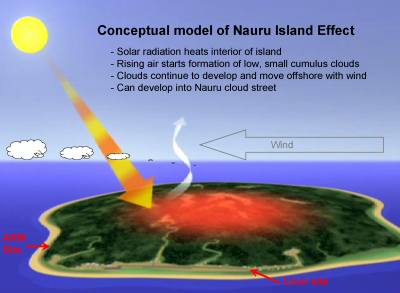New Datastream Identifies Nauru Data Influenced by Clouds
Published: 5 August 2010
A new data set that identifies periods when Nauru data may be affected by island-influenced clouds has been produced by Chuck Long, site scientist for the ARM Tropical Western Pacific site. The Nauru island effect (NIE) data set currently covers the period from September 2005 to May 2010 and will be updated periodically as new data are obtained. This data set will help scientists in their analysis of cloud and radiation data at Nauru and will enable them to perform more relevant comparisons of observations and model results.

Based on the algorithm developed by McFarlane et al. (2005), statistical analysis of the wind direction and air temperature at the site and downwelling shortwave radiation at the two sites now can be used to identify likely occurrences of an island influence on the Nauru data. Subsequently, a permanent set of Licor pyranometers have been installed near the airport on the southern end of the island for use in applying the island effect detection methodology.
Affected ARM data will be periodically identified and made available through the Nauru Island Effect Detection Data Set available at the ARM Data Archive; a user login is required. Questions? Contact Chuck Long (chuck.long@pnl.gov) or Sally McFarlane (sally.mcfarlane@pnl.gov).
The ARM Climate Research Facility is a DOE Office of Science user facility. The ARM Facility is operated by nine DOE national laboratories, including .
Keep up with the Atmospheric Observer
Updates on ARM news, events, and opportunities delivered to your inbox
ARM User Profile
ARM welcomes users from all institutions and nations. A free ARM user account is needed to access ARM data.


















